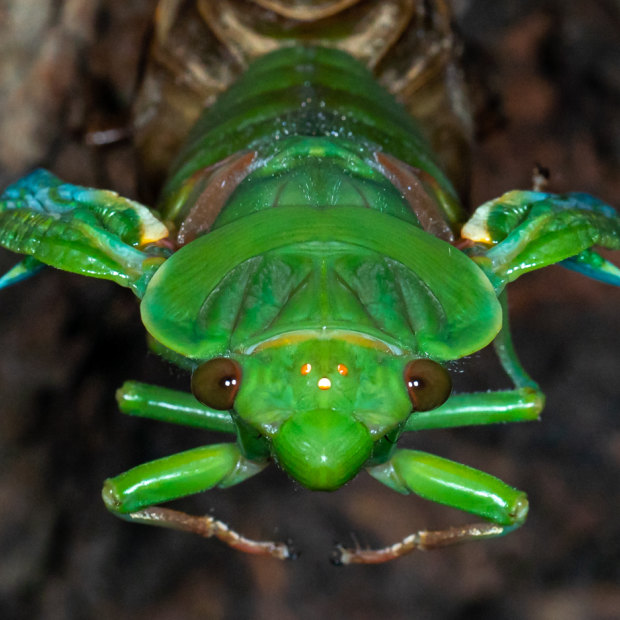
A greengrocer cicada emerges from its shell. Credit: Nathan Emery
It was a coincidence so uncanny the experts could barely believe it. In late September, seven years to the day the crispy shells of a mass cicada brood last littered NSW’s Blue Mountains, an army of nymphs arose once more.
“The big emergence was the night of the 23rd of September, which was exactly the same night as they all came out in 2017,” University of Sydney cicada expert Professor David Emery said. “It’s absolutely, incredibly amazing.”
This season is shaping up to be a huge one for greengrocer cicadas after a mass emergence of the “masked devil” subtype in the mountains west of Sydney, heralding the onset of a roaring summer.
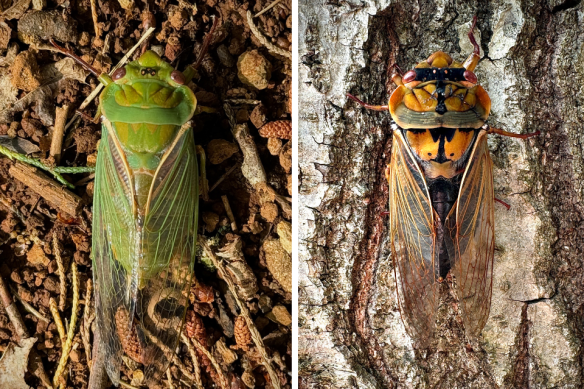
A classic greengrocer (left) compared with its “masked devil” colour morph (right) in the Blue Mountains.Credit: Wolter Peeters
Emery and his son, Dr Nathan Emery, are two of the few cicada researchers in Australia trying to nail down what climatic forces or biological cycles trigger earsplitting cicada summers.
Greengrocers, the most common cicada in NSW and Victoria, can appear as different “colour morphs” depending on their levels of blue and yellow pigment.
A normal balance produces a classic, grass-coloured greengrocer. A lack of blue brings about a “yellow monday”. And a lack of yellow conjures the most coveted cicada: the “blue moon”, a brilliant turquoise marvel.
Another recently observed dark subtype has been dubbed the “black bandit”. The Versace-patterned masked devils dominate higher altitudes.
And that’s all just one species.
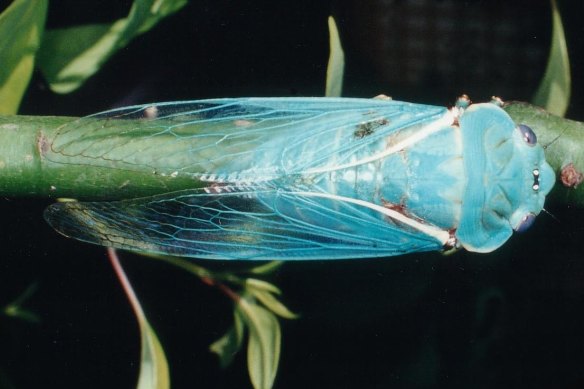
A super rare “blue moon” colour morph of the greengrocer cicada.Credit: David Emery
Only about half of the other 1000-odd cicada species in Australia have been described. “We’re pretty much the cicada capital of the world,” said Nathan, who alongside his father is working to categorise and describe new species.
The mathematical insect
It’s been a big year for cicadas, here and abroad. The insects hatch on branches as spidery nymphs that burrow underground. For years, they live a subterranean and vampiric existence, seeking out tree roots to suck out the sap.
In the US, Magicicadas are famed for their periodical emergence. Some burst from the ground every 13 years, others every 17 years. They emerge so reliably ecologists have mapped and split the groups into different “broods” and know which year each one will materialise.
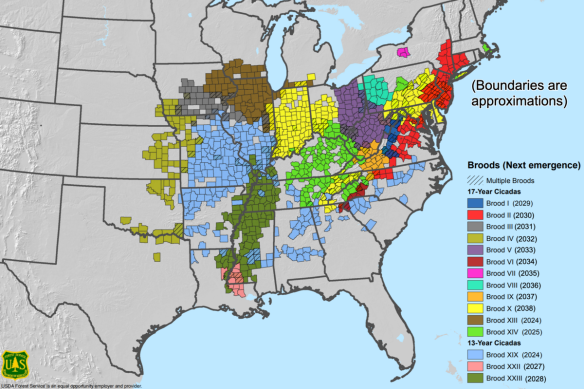
Map of periodical US cicada brood locations by county and timing of next emergence.Credit: USDA Forest Service
Thirteen and 17-year cicadas don’t often emerge in unison, and the two specific broods that came out in 2024 haven’t coincided since 1803. The resulting bellow was so alarming residents of South Carolina reported the roar to police.
We have less data on Australian cicadas, but greengrocers seem to peak about every seven years (although there was also a strong showing in 2021).
Seven, 13 and 17 are all prime numbers – a mathematical quirk that could belie an evolutionary strategy.
Prime numbers are only divisible by themselves and one. Cicadas’ prime number schedules, some scientists believe, make it less likely they’ll coincide with a peak predator population.
If a type of cicada-hunting bird boomed every six years, for example, a 17-year cicada brood would coincide with the peak predator year just once every 102 years. If the cicadas emerged every 12 years instead, they’d be vulnerable to predators that peak every 12, six, four, three and two years.
To help identify Australian cicada cycles, Nathan began a citizen science project called the Great Cicada Blitz, where people record calls and upload sightings to generate data about when mass emergences occur. He’s started to model weather data to see if there are climatic triggers; a bout of rain and double-digit warm temperatures overnight in early spring may help.
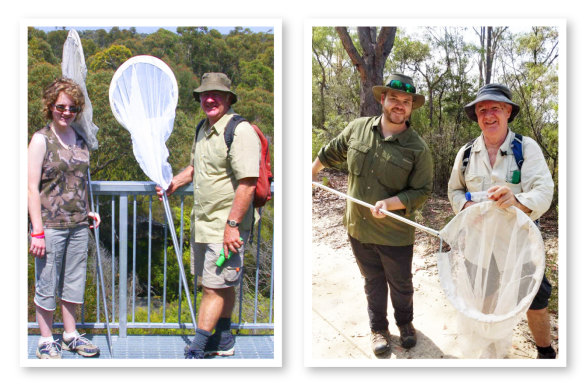
It’s a family affair: Professor David Emery on the lookout for cicadas with his daughter, Samantha, and son, Nathan, who also became a cicada researcher.Credit:
Cicadas normally call for a mate at dusk, but greengrocers are currently singing in force during the day, which they do only in high numbers. One can shriek at over 100 decibels (about as loud as a blender) and each additional cicada adds one or two decibels to the din, which grows so loud predators are repelled.
What’s in a name?
The citizen science project has helped discover new species of the Yoyetta genus, a group that includes the “firetails” with striking red bellies, and David is working on categorising 11 more in the genus.
There are already enough known cicadas to populate a fairy tale: the black prince and the silver princess (who loves bottlebrush); golden emperors and little barons; chocolate soldiers and brown bunyips; red-nosed whiskey drinkers and white-dusted floury bakers. There are scratchers, sprinklers, squeakers and squawkers. Clickers, clangers, buzzers and tickers.
Where did this flamboyant taxonomy come from?
“A lot of them were coined by kids decades ago in the 70s and 80s, and they’ve just stuck,” Nathan, whose father inspired his obsession, said.
David as a child on the NSW South Coast used to pluck greengrocers from outside and place them on the family Christmas tree.
“They’re associated with holidays, presents and going on holiday,” David said. “Cicadas are just part of summer – they’ve part of our folklore.”
Enjoyed reading this week’s Examine article? Sign up to get the whole newsletter in your inbox.